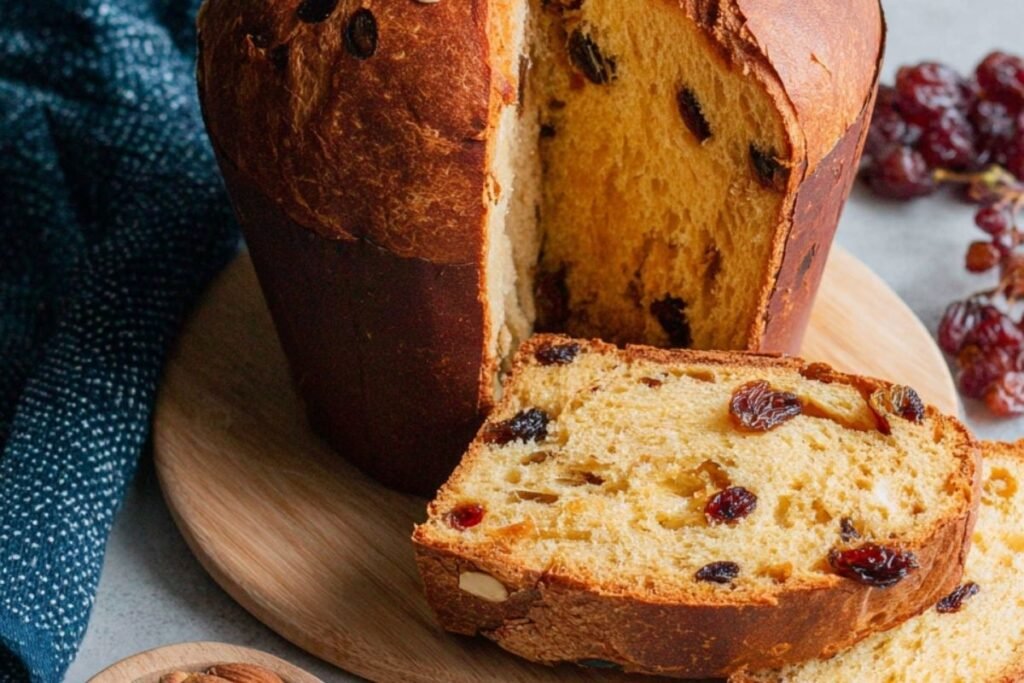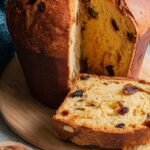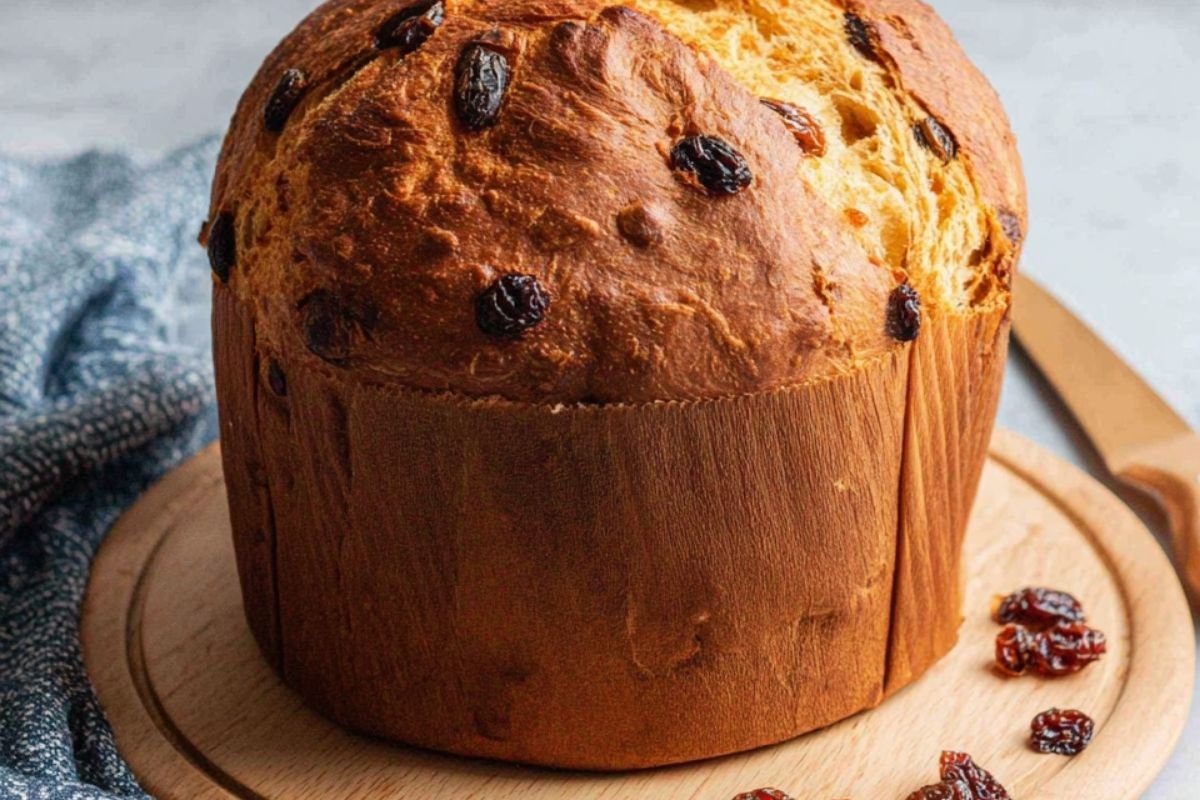Few holiday breads are as iconic and celebratory as Italian Panettone. Towering, golden, and filled with candied fruit and raisins, this sweet bread has become a symbol of Italian Christmas baking—one that’s recognized around the world.
In this complete guide, we explore everything you need to know about Panettone: from its history and cultural significance to the intricacies of its ingredients, the art of the long rise, how to master the dome shape, and how to make it your own with variations.
Ready to make the most authentic, fluffy, and flavorful Italian Panettone from scratch? Let’s dive into a Christmas tradition that dates back centuries but continues to light up tables today.
📖 Table of Contents
- What Is Italian Panettone?
- History and Cultural Roots
- The Science Behind the Ingredients
- Step-by-Step Recipe Instructions
- Variations of Panettone
- How to Store and Serve
- Troubleshooting Common Problems
- Frequently Asked Questions (FAQs)
- Conclusion
1. What Is Italian Panettone?
Italian Panettone is a rich, yeasted sweet bread originating in Milan. It’s typically baked in a tall cylindrical mold and studded with raisins, candied orange peel, and sometimes even chocolate or nuts. The dough is incredibly soft, light, and stretchy—like a cross between bread and cake.
Traditionally eaten during Christmas and New Year, panettone is sliced and served plain or with accompaniments like sweet spreads, butter, or even mascarpone cream.
What makes Panettone unique is not just its height or flavor, but the process: it involves multiple stages of rising, aging, and carefully crafted fermentation that can take up to two or three days—but the results are well worth it.
2. History and Cultural Roots
Origins in Milan
The story of Panettone begins in Milan, Italy, during the Renaissance. According to one legend, the dessert was invented by a young nobleman who disguised himself as a baker to win the heart of a baker’s daughter. His rich, fruit-studded bread was a hit—and the rest is history.
The Name
The word Panettone comes from “panetto” (small bread), with the suffix “-one” denoting something large. Thus, panettone literally means “big bread”—a fitting name for its towering, dome-like shape.
A Holiday Tradition
By the 20th century, panettone became a staple during Italian Christmas celebrations. It’s now enjoyed across the world, often gifted in decorative boxes during the holidays.
In Italy, it’s more than a dessert—it’s a symbol of abundance, sharing, and family.
3. The Science Behind the Ingredients
Flour
A strong high-protein flour (such as bread flour) is essential for developing the dough’s gluten network, which supports its tall shape.
Yeast
Traditional panettone uses natural sourdough starter, but many home bakers use active dry yeast for reliable results.
Eggs and Butter
These provide richness and tenderness. Panettone is a brioche-style dough, enriched with fat and sugar.
Sugar
Not only for sweetness—sugar feeds the yeast and helps with browning.
Milk
Adds moisture and tenderness. Some recipes use water, but milk gives a richer flavor.
Flavorings
- Vanilla, orange zest, lemon zest – Brightens and balances the rich dough
- Candied orange peel & raisins – The classic inclusions
- Chocolate chips or chopped nuts – Modern options for variation
- Almond glaze (optional) – For bakery-style finish
4. Step-by-Step Recipe Instructions
This version uses active dry yeast, making it more accessible while keeping the traditional flavor and texture.
🍞 Ingredients (U.S. Measurements)

For the Dough:
- 1 cup whole milk (warm, about 110°F)
- 2¼ tsp (1 packet) active dry yeast
- ½ cup granulated sugar
- 4 large egg yolks
- 2 large eggs
- 1 tsp vanilla extract
- 1 tsp salt
- Zest of 1 orange and 1 lemon
- 4 cups bread flour
- ¾ cup unsalted butter, softened
Filling:
- ¾ cup raisins
- ¾ cup chopped candied orange peel
- 2 tbsp orange juice (for soaking raisins)
For Topping (optional):
- 1 beaten egg (for egg wash)
- Powdered sugar for dusting
👩🍳 Directions
Step 1: Soak the Fruit
Soak raisins in orange juice for at least 30 minutes to plump them. Drain and pat dry.
Step 2: Activate the Yeast
In a mixing bowl, stir yeast and 1 tbsp sugar into the warm milk. Let sit 5–10 minutes until foamy.
Step 3: Make the Dough
Add egg yolks, eggs, sugar, zest, vanilla, and salt to the yeast mixture. Mix to combine. Slowly incorporate the flour until a soft dough forms. Knead for 8–10 minutes.
Step 4: Add the Butter
Add softened butter, one tablespoon at a time, kneading well after each addition. Dough should be smooth and elastic.
Step 5: First Rise
Place dough in a greased bowl. Cover and let rise in a warm place for 1½–2 hours, or until doubled.
Step 6: Add Fruit
Punch down dough. Knead in raisins and candied orange peel until evenly distributed.
Step 7: Shape and Proof
Form into a ball and place in a tall panettone mold (or use a deep cake pan with a parchment collar). Let rise until dough nearly reaches the top—about 1½–2 hours.
Step 8: Preheat and Bake
Preheat oven to 350°F. Brush top with beaten egg. Bake for 40–50 minutes until golden brown and a skewer comes out clean. Tent with foil if browning too fast.
Step 9: Cool Upside Down (Optional but Traditional)
To prevent collapse, poke skewers through the bottom and hang the panettone upside down over a pot to cool. If skipping this, cool on a wire rack.
5. Variations of Panettone
Once you’ve mastered the classic, try these popular versions:
- Chocolate Panettone – Add dark chocolate chips or chunks
- Nut & Fig Panettone – Swap fruit for chopped figs and toasted hazelnuts
- Limoncello Glaze – Brush with lemon syrup after baking
- Mini Panettones – Bake in muffin tins for gifts
- Savory Panettone – A modern twist with cheese, olives, or herbs
6. How to Store and Serve
Serving Suggestions:
- Slice and serve plain or with:
- Butter
- Mascarpone cheese
- Jam or fruit preserves
- Espresso or dessert wine
Storing:
- Wrap tightly in plastic wrap and foil. Store at room temperature for up to 7–10 days.
- Do not refrigerate—it dries out.
- Freeze up to 2 months (sliced or whole).
7. Troubleshooting Common Problems
Panettone didn’t rise well?
Your yeast may have been old or the room too cool. Try a proofing box or warm oven (turned off).
Dough too sticky?
It’s a wet dough—use oiled hands or chill before shaping. Avoid adding too much extra flour.
Fruit sank to the bottom?
Toss fruit in flour before adding to the dough. Ensure it’s evenly distributed.
Dome collapsed?
Usually from underbaking or cooling too quickly. Try the upside-down cooling method.
Crust too dark?
Tent with foil halfway through baking to avoid over-browning.
8. Frequently Asked Questions (FAQs)
Q: What makes panettone different from other breads?
It’s enriched with butter, eggs, and sugar—like brioche—but has a much longer fermentation and a light, feathery crumb.
Q: Can I use instant yeast?
Yes, reduce the amount by about 25% and skip the proofing step.
Q: Do I need a special panettone mold?
It helps with the height and shape, but you can also use a deep 6-inch cake pan with a tall parchment collar.
Q: How long does it take to make panettone?
With rising and shaping, expect 12–24 hours total, or more with sourdough.
Q: Can I make it without fruit?
Absolutely. Try chocolate chips, chopped nuts, or leave plain.
9. Conclusion
Baking Italian Panettone at home may feel ambitious, but it’s one of the most rewarding holiday baking experiences you can have. It’s more than just bread—it’s tradition, celebration, and a symbol of sharing.
Whether you stick with the classic version or explore modern variations, panettone brings warmth and joy to any festive table. So tie on your apron, knead with patience, and let this golden loaf become part of your Christmas story.
Buon Natale and happy baking!
Print
Traditional Italian Panettone: The Ultimate Baking Guide 🎄
Ingredients
For the Dough:
-
1 cup whole milk (warm, about 110°F)
-
2¼ tsp (1 packet) active dry yeast
-
½ cup granulated sugar
-
4 large egg yolks
-
2 large eggs
-
1 tsp vanilla extract
-
1 tsp salt
-
Zest of 1 orange and 1 lemon
-
4 cups bread flour
-
¾ cup unsalted butter, softened
Filling:
-
¾ cup raisins
-
¾ cup chopped candied orange peel
-
2 tbsp orange juice (for soaking raisins)
For Topping (optional):
-
1 beaten egg (for egg wash)
-
Powdered sugar for dusting
Instructions
Step 1: Soak the Fruit
Soak raisins in orange juice for at least 30 minutes to plump them. Drain and pat dry.
Step 2: Activate the Yeast
In a mixing bowl, stir yeast and 1 tbsp sugar into the warm milk. Let sit 5–10 minutes until foamy.
Step 3: Make the Dough
Add egg yolks, eggs, sugar, zest, vanilla, and salt to the yeast mixture. Mix to combine. Slowly incorporate the flour until a soft dough forms. Knead for 8–10 minutes.
Step 4: Add the Butter
Add softened butter, one tablespoon at a time, kneading well after each addition. Dough should be smooth and elastic.
Step 5: First Rise
Place dough in a greased bowl. Cover and let rise in a warm place for 1½–2 hours, or until doubled.
Step 6: Add Fruit
Punch down dough. Knead in raisins and candied orange peel until evenly distributed.
Step 7: Shape and Proof
Form into a ball and place in a tall panettone mold (or use a deep cake pan with a parchment collar). Let rise until dough nearly reaches the top—about 1½–2 hours.
Step 8: Preheat and Bake
Preheat oven to 350°F. Brush top with beaten egg. Bake for 40–50 minutes until golden brown and a skewer comes out clean. Tent with foil if browning too fast.
Step 9: Cool Upside Down (Optional but Traditional)
To prevent collapse, poke skewers through the bottom and hang the panettone upside down over a pot to cool. If skipping this, cool on a wire rack.
